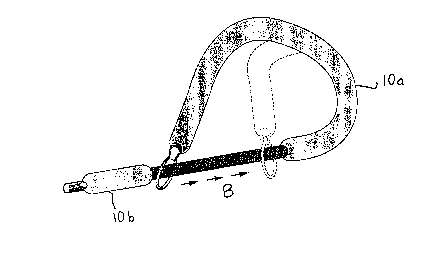Une partie des informations de ce site Web a été fournie par des sources externes. Le gouvernement du Canada n'assume aucune responsabilité concernant la précision, l'actualité ou la fiabilité des informations fournies par les sources externes. Les utilisateurs qui désirent employer cette information devraient consulter directement la source des informations. Le contenu fourni par les sources externes n'est pas assujetti aux exigences sur les langues officielles, la protection des renseignements personnels et l'accessibilité.
L'apparition de différences dans le texte et l'image des Revendications et de l'Abrégé dépend du moment auquel le document est publié. Les textes des Revendications et de l'Abrégé sont affichés :
| (12) Demande de brevet: | (11) CA 2276084 |
|---|---|
| (54) Titre français: | NOEUD COULANT POUR SAUVETAGE MARITIME |
| (54) Titre anglais: | MARINE RESCUE SNARE |
| Statut: | Réputée abandonnée et au-delà du délai pour le rétablissement - en attente de la réponse à l’avis de communication rejetée |
| (51) Classification internationale des brevets (CIB): |
|
|---|---|
| (72) Inventeurs : |
|
| (73) Titulaires : |
|
| (71) Demandeurs : |
|
| (74) Agent: | SMART & BIGGAR LP |
| (74) Co-agent: | |
| (45) Délivré: | |
| (22) Date de dépôt: | 1999-06-23 |
| (41) Mise à la disponibilité du public: | 1999-12-25 |
| Requête d'examen: | 2000-04-05 |
| Licence disponible: | S.O. |
| Cédé au domaine public: | S.O. |
| (25) Langue des documents déposés: | Anglais |
| Traité de coopération en matière de brevets (PCT): | Non |
|---|
| (30) Données de priorité de la demande: | ||||||
|---|---|---|---|---|---|---|
|
A floatable marine rescue snare is provided
comprising one or more buoyant elongate rods axially
connected by a tie line and formed in a loop, with
slippage means fixed to one end of the snare and slidably
engaged with a portion of the snare between its two ends.
The tie line connects to a rescue rope by which it may be
thrown to a victim. Once looped around the upper torso
of the victim, the snare can be tightened by pulling on
the rescue rope to secure a rescue link while the buoyant
body of the snare maintains the victim afloat.
Note : Les revendications sont présentées dans la langue officielle dans laquelle elles ont été soumises.
Note : Les descriptions sont présentées dans la langue officielle dans laquelle elles ont été soumises.

2024-08-01 : Dans le cadre de la transition vers les Brevets de nouvelle génération (BNG), la base de données sur les brevets canadiens (BDBC) contient désormais un Historique d'événement plus détaillé, qui reproduit le Journal des événements de notre nouvelle solution interne.
Veuillez noter que les événements débutant par « Inactive : » se réfèrent à des événements qui ne sont plus utilisés dans notre nouvelle solution interne.
Pour une meilleure compréhension de l'état de la demande ou brevet qui figure sur cette page, la rubrique Mise en garde , et les descriptions de Brevet , Historique d'événement , Taxes périodiques et Historique des paiements devraient être consultées.
| Description | Date |
|---|---|
| Inactive : CIB de MCD | 2006-03-12 |
| Demande non rétablie avant l'échéance | 2004-10-12 |
| Inactive : Morte - Taxe finale impayée | 2004-10-12 |
| Réputée abandonnée - omission de répondre à un avis sur les taxes pour le maintien en état | 2004-06-23 |
| Réputée abandonnée - les conditions pour l'octroi - jugée non conforme | 2003-10-10 |
| Un avis d'acceptation est envoyé | 2003-04-10 |
| Lettre envoyée | 2003-04-10 |
| Un avis d'acceptation est envoyé | 2003-04-10 |
| Inactive : Approuvée aux fins d'acceptation (AFA) | 2003-03-31 |
| Modification reçue - modification volontaire | 2000-05-15 |
| Lettre envoyée | 2000-04-27 |
| Exigences pour une requête d'examen - jugée conforme | 2000-04-05 |
| Toutes les exigences pour l'examen - jugée conforme | 2000-04-05 |
| Requête d'examen reçue | 2000-04-05 |
| Demande publiée (accessible au public) | 1999-12-25 |
| Inactive : Page couverture publiée | 1999-12-24 |
| Inactive : CIB en 1re position | 1999-08-19 |
| Inactive : Certificat de dépôt - Sans RE (Anglais) | 1999-08-05 |
| Exigences de dépôt - jugé conforme | 1999-08-05 |
| Demande reçue - nationale ordinaire | 1999-08-03 |
| Date d'abandonnement | Raison | Date de rétablissement |
|---|---|---|
| 2004-06-23 | ||
| 2003-10-10 |
Le dernier paiement a été reçu le 2003-05-22
Avis : Si le paiement en totalité n'a pas été reçu au plus tard à la date indiquée, une taxe supplémentaire peut être imposée, soit une des taxes suivantes :
Veuillez vous référer à la page web des taxes sur les brevets de l'OPIC pour voir tous les montants actuels des taxes.
| Type de taxes | Anniversaire | Échéance | Date payée |
|---|---|---|---|
| Taxe pour le dépôt - petite | 1999-06-23 | ||
| Requête d'examen - petite | 2000-04-05 | ||
| TM (demande, 2e anniv.) - petite | 02 | 2001-06-26 | 2001-06-26 |
| TM (demande, 3e anniv.) - petite | 03 | 2002-06-24 | 2002-05-15 |
| TM (demande, 4e anniv.) - petite | 04 | 2003-06-23 | 2003-05-22 |
Les titulaires actuels et antérieures au dossier sont affichés en ordre alphabétique.
| Titulaires actuels au dossier |
|---|
| K. CRAIGE KELLETT |
| Titulaires antérieures au dossier |
|---|
| S.O. |